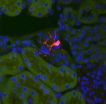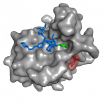(Press-News.org) ROCHESTER, Minn. -- Most patients with triple-negative breast cancer should undergo genetic testing for mutations in known breast cancer predisposition genes, including BRCA1 and BRCA2, a Mayo Clinic-led study has found. The findings come from the largest analysis to date of genetic mutations in this aggressive form of breast cancer. The results of the research appear in the Journal of Clinical Oncology.
"Clinicians need to think hard about screening all their triple-negative patients for mutations because there is a lot of value in learning that information, both in terms of the risk of recurrence to the individual and the risk to family members. In addition, there may be very specific therapeutic benefits of knowing if you have a mutation in a particular gene," says Fergus Couch, Ph.D., professor of laboratory medicine and pathology at Mayo Clinic and lead author of the study.
The study found that almost 15 percent of triple-negative breast cancer patients had deleterious (harmful) mutations in predisposition genes. The vast majority of these mutations appeared in genes involved in the repair of DNA damage, suggesting that the origins of triple-negative breast cancer may be different from other forms of the disease. The study also provides evidence in support of the National Comprehensive Cancer Network (NCCN) guidelines for genetic testing of triple-negative breast cancer patients.
Triple-negative breast cancer is a specific subset of breast cancer that makes up about 12 to 15 percent of all cases. The disease is difficult to treat because the tumors are missing the estrogen, progesterone and HER-2 receptors that are the target of the most common and most effective forms of therapy. However, recent studies have suggested that triple-negative breast cancer patients might harbor genetic mutations that make them more likely to respond to alternative treatments like cisplatin, a chemotherapy agent, or PARP inhibitors, anti-cancer agents that inhibit the poly (ADP-ribose) polymerase (PARP) family of enzymes.
Dr. Couch and his colleagues decided to assess the frequency of mutations in predisposition genes in patients with triple-negative breast cancer to further delineate the role of genetic screening for individuals with the disease. The researchers sequenced DNA from 1,824 triple-negative breast cancer cases seen at 12 oncology clinics in the U.S. and Europe, as part of the Triple-Negative Breast Cancer Consortium.
They found deleterious mutations in almost 15 percent of triple-negative breast cancer patients. Of these, 11 percent had mutations in the BRCA1 and BRCA2 genes and the rest had mutations in 15 other predisposition genes, including the DNA repair genes PALB2, BARD1, and RAD51C. No mutations were found in predisposition genes involved in other processes like the cell cycle.
"Triple-negative breast cancers are different from all the other breast cancers," says Dr. Couch. "Other studies have suggested that this form of the disease might be associated with some defect in DNA repair, and our study verifies that. Our findings generate a whole new set of hypotheses about how triple-negative breast cancer might be arising, which could give us better ideas for prevention or new therapies for this disease."
The study also found that individuals with mutations in predisposition genes were diagnosed at an earlier age and had higher-grade tumors than those without mutations. The researchers used their dataset to assess whether the current screening guidelines would identify all the triple-negative individuals with mutations in the two most common predisposition genes, BRCA1 and BRCA2.
They found that the NCCN guidelines, which recommend screening when there is a family history of cancer or a diagnosis under age 60, missed only 1 percent of patients carrying mutations. In contrast, the UK's National Institute for Clinical Excellence (NICE) guidelines, which use the probability of actually finding a mutation to determine who should be tested, missed 24 percent of mutation carriers.
"Our results confirm that the NCCN guidelines are good, and provide evidence to support what they have recommended," says Dr. Couch. "But we think the NICE guidelines could be expanded to include more of the triple-negative breast cancer patients with mutations."
INFORMATION:
Co-authors from Mayo Clinic include, Steven N. Hart, Ph.D. , Curtis Olswold, Seth Slettedahl, Emily Hallberg, Jaime I. Davila, Susan L. Slager, Ph.D., Celine M. Vachon, Ph.D.
The National Institutes of Health, the Breast Cancer Research Foundation and the David F. and Margaret T. Grohne Family Foundation funded the study.
About Mayo Clinic Cancer Center
As a leading institution funded by the National Cancer Institute, Mayo Clinic Cancer Center conducts basic, clinical and population science research, translating discoveries into improved methods for prevention, diagnosis, prognosis and therapy. For information on cancer clinical trials, call 1-855-776-0015 (toll-free).
About Mayo Clinic
Mayo Clinic is a nonprofit organization committed to medical research and education, and providing expert, whole-person care to everyone who needs healing. For more information, visit http://www.mayoclinic.org/about-mayo-clinic or http://newsnetwork.mayoclinic.org.
Researchers from Brigham and Women's Hospital (BWH) have identified what they believe to be the cells responsible for fibrosis, the buildup of scar tissue. Fibrotic diseases, such as chronic kidney disease and failure, lung disease, heart failure and cirrhosis of the liver, are estimated to be responsible for up to 45 percent of deaths in the developed world.
The findings are published online in the journal Cell Stem Cell.
"Previous research indicated that myofibroblasts are the cells responsible for fibrosis," said Benjamin Humphreys, MD, PhD, senior author of ...
New research from North Carolina State University and the University of Minnesota shows that the majority of consumers will accept the presence of nanotechnology or genetic modification (GM) technology in foods - but only if the technology enhances the nutrition or improves the safety of the food.
"In general, people are willing to pay more to avoid GM or nanotech in foods, and people were more averse to GM tech than to nanotech," says Dr. Jennifer Kuzma, senior author of a paper on the research and co-director of the Genetic Engineering in Society Center at NC State. ...
Bethesda, MD (Dec. 2, 2014) -- Women with celiac disease present with fertility problems no more often than women in the general population, according to a new study in Gastroenterology1, the official journal of the American Gastroenterological Association.
"Despite inconsistent findings from small studies, concern has been raised that celiac disease may cause infertility," said lead study author Nafeesa N. Dhalwani, PhD, from the University of Nottingham, United Kingdom. "Celiac patients should rest assured; our findings indicate that women with celiac disease do not ...
A research team from Kiel University (CAU) and Goethe University Frankfurt has jointly created a synthetic surface on which the adhesion of E. coli bacteria can be controlled. The layer, which is only approximately four nanometres thick, imitates the saccharide coating (glycocalyx) of cells onto which the bacteria adhere such as during an infection. This docking process can be switched on and off using light. This means that the scientists have now made an important step towards understanding the relationship between sugar (carbohydrates) and bacterial infections. Their ...
This news release is available in German.
The FK506-binding protein 51 (FKBP51) is an established risk factor for stress-related psychiatric disorders such as major depression. Drug discovery for FKBP51 has been hampered by the inability to pharmacologically differentiate against the very similar functional counterplayer FKBP52. Scientists at the Max Planck Institute of Psychiatry in Munich have now developed the first potent and highly selective inhibitor of FKBP51. The so-called SAFit-ligand inhibits FKBP51 enhancing growth of neuronal cell cultures and improving ...
Molecular clocks -- based on changes in genetic material -- indicate much younger ages for a wide variety of plants found as fossils in southern Argentina than do the solid, geologic dates of those fossils, according to geoscientists who surveyed recent paleobotanical discoveries in Patagonia.
The finding suggests serious biases in molecular clocks, which are heavily used to date many kinds of living things. It also directly refutes a widely-held idea about how most Southern Hemisphere plant and animal groups attained their current distributions.
Geologists date fossils ...
A team of scientists has revealed how certain harmful bacteria drill into our cells to kill them. Their study shows how bacterial 'nanodrills' assemble themselves on the outer surfaces of our cells, and includes the first movie of how they then punch holes in the cells' outer membranes. The research, published today in the journal eLife, supports the development of new drugs that target this mechanism, which is implicated in serious diseases. The team brings together researchers from UCL, Birkbeck, University of London, the University of Leicester, and Monash University ...
In the city that never sleeps, it's easy to overlook the insects underfoot. But that doesn't mean they're not working hard. A new study from North Carolina State University shows that insects and other arthropods play a significant role in disposing of garbage on the streets of Manhattan.
"We calculate that the arthropods on medians down the Broadway/West St. corridor alone could consume more than 2,100 pounds of discarded junk food, the equivalent of 60,000 hot dogs, every year - assuming they take a break in the winter," says Dr. Elsa Youngsteadt, a research associate ...
ARLINGTON HEIGHTS, Ill. (December 2, 2014) - If you are one of the millions of Americans who experiences a severe allergic reaction to food, latex or an insect sting, you should know the first line of defense in combating the reaction is epinephrine. Unfortunately, not all medical personnel know how important epinephrine is in bringing an allergic reaction under control.
According to new guidelines published in the Annals of Allergy, Asthma and Immunology, the scientific publication of the American College of Allergy, Asthma and Immunology (ACAAI), the fast administration ...
AUSTIN, Texas -- Researchers at The University of Texas at Austin have identified a network of genes that appear to work together in determining alcohol dependence. The findings, which could lead to future treatments and therapies for alcoholics and possibly help doctors screen for alcoholism, are being published this week in the journal Molecular Psychiatry.
By comparing patterns of genetic code from the brain tissue of alcoholics and nonalcoholics, the researchers discovered a particular set of genes co-expressed together in the individuals who had consumed the most ...


